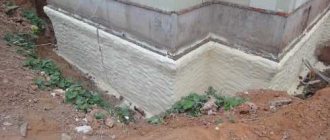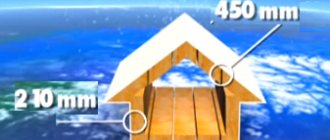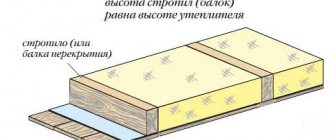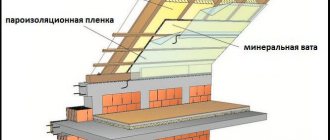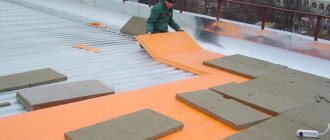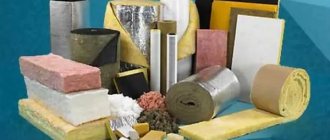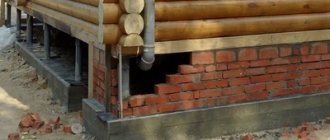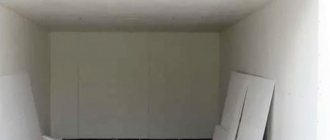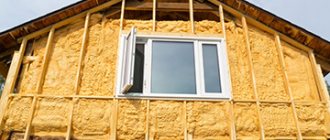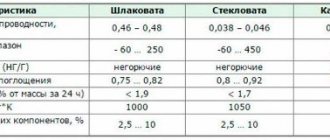- home
- Services
- Residential insulation
- Roof insulation with polyurethane foam
—
—
—
| Thermal insulation with polyurethane foam Ecotermix | |||||
| Service | Price, m2 | ||||
| Roof insulation | 740 rub. | ||||
Roof insulation is one of the important stages in the thermal insulation of a house, since heat loss through the roof accounts for a significant portion of the heat costs of the entire building. Especially if the thermal protection of the roof is performed poorly, using ineffective insulation materials.
The main problem that home owners face when using roll and slab insulation is the gradual deterioration of the thermal protection properties in the places where these insulation is installed.
Often, home owners follow the lead of market “professionals” who recommend outdated mineral wool thermal insulation and do not want to delve into the essence of the issue. Although there are studies that indicate that after just a few years of operation, the thermal insulation properties of mineral wool are significantly reduced.
Another myth associated with mineral wool is its cheapness. Indeed, if you buy several packages of mineral wool and calculate the cost of 1 m3, you will get an amount of only about 2 thousand rubles. However, the costs are just beginning; then you need to pay for transporting a large volume of mineral wool to the site, ensure its storage in a dry place, before directly installing it in the structural elements of the house.
The cost of installing mineral wool will be about 300 rubles per m2 or 1.5 thousand per 1 m3. It is also necessary to take into account that when installing mineral wool, about 10% will be scraps, which also need to be disposed of.
Mineral wool requires special operating conditions, so the roof structure must be installed in a special way: you will need 2 ventilation gaps, a vapor barrier film, and aerators. All this not only increases the cost of the design, but also creates a lot of opportunities for errors during installation, which can negate the efforts to install this thermal insulation.
Thus, if you collect all the costs for the purchase and installation of mineral wool, you will get an amount comparable to the cost of spraying polyurethane foam.
The estimate illustrates that the cost of insulation and work with polyurethane foam would be 2,207 rubles including materials and work instead of 3,758 rubles with mineral wool.
In addition, operating costs for heating a house when using mineral wool will be on average 30-70% higher than when using polyurethane foam. This difference will increase over the years, as the efficiency of mineral wool decreases every year.
Types of polyurethane foam and its composition
As mentioned earlier, PPU (polyurethane foam) is a foamed plastic formed during a chemical reaction and having a large number of gas cells. The hardened mass of plastic accounts for only about 2%, while the remaining 98% comes from a mixture of carbon dioxide and air masses. It is thanks to this fine-cell structure that polyurethane foam has high thermal insulation properties, low weight and the ability to retain air vapor. For thermal insulation of roofs and floors, 2 types of polyurethane foam are used:
Elastic polyurethane foam
If the density of the material does not exceed 20 kg per cubic meter, then such a material is called elastic. Foam insulation is produced in the form of rolls or layers. It is very convenient to use such insulation in work. Due to the presence of a large number of cells in it, it is quite pliable, bends easily and quickly restores its original shape. The main frozen volume of elastic polyurethane foam has a density of 8 to 15 kg per cubic meter. With its help, you can carry out work both on insulating the internal ceiling and insulating the external slopes of the roof. In addition to ease of use and high insulation characteristics, polyurethane foam has another important property - sound insulation. Installing such insulation is quite simple. You just need to lay it between the wooden floor slings and secure it.
Rigid polyurethane foam
Hard polyurethane foam is a material formed from foamed plastic and also has a large number of small cells with gas. What makes it tough is the presence of up to 3% solids in the composition. Thanks to this, such a material has a structure characterized by high rigidity, low weight and resistance to various types of damage (both mechanical and chemical). Its density is approximately 2-3 times higher than the density of liquid polyurethane foam and reaches 60 kg per cubic meter. The cost of performing thermal insulation work using solid polyurethane foam directly depends on the thickness of the layer being laid.
Expert opinion
Konstantin Alexandrovich
Compared to other thermal insulation materials, the cost of roof and ceiling insulation using polyurethane foam is lower. The final cost of insulation work depends both on the size of the roof slope, its shape, and on the thickness of the applied layer. Experienced roofing repair specialists estimate that 50 to 100 mm of polyurethane foam should be sprayed. It is a layer of this thickness that will have high thermal efficiency and protect the house from the cold. The price in this case will vary from 200 to 500 rubles per square meter.
Advantages of using polyurethane foam insulation for roofing
- Polyurethane foam insulation ensures complete tightness of the roof - this can be achieved thanks to a special method of application by spraying. Polyurethane foam is applied to any surface using special equipment, which allows it to cover every square millimeter of any structure, even the most intricate shapes. During operation, polyurethane foam foams, increasing in volume up to 100 times, this allows you to completely seal any joints and cracks.
- Minimal loads on the roof and supporting structures - a cubic meter of polyurethane foam weighs less than ten kilograms! This is explained by the fact that 90% of this material consists of air. This ensures the highest efficiency of thermal protection, as well as sound insulation.
- The material does not burn and does not support combustion - this significantly increases the level of fire safety. Even with prolonged exposure to open fire, polyurethane foam does not emit any toxic substances.
- Durability – the service life of polyurethane foam is at least 50 years without loss of properties.
- Resistance to mechanical stress - the material is quite elastic and responds well to thermal expansion and deformation of the base.
Preparatory work
Before installing thermal insulation using polyurethane foam, you should make sure that the equipment used is reliable, and also study the technical installation procedure itself. Despite the fact that the installation work is quite simple, there are certain rules. Compliance with them guarantees you high-quality thermal insulation, which will have a long service life and high insulating characteristics.
Some unprofessional craftsmen ignore the preparatory work stage. There is no way to do this. In the future, this will only lead to a deterioration in the efficiency of insulation and a significant increase in the costs of installation and thermal insulation material.
Before you begin applying polyurethane foam to the insulated surface, you must perform the following steps:
- Check the serviceability of equipment used for spraying polyurethane foam.
- Make sure you have the required amount of materials for the job.
- Carry out work to prepare the insulated surface, on which a layer of thermal insulation will be applied.
- Spray a control layer of material and check its quality.
Note! For spraying polyurethane foam, both professional equipment and special disposable installations can be used.
A variety of surfaces are suitable for applying polyurethane foam. Most often, insulation is applied to concrete, brick, wood or metal coatings. The requirements for the quality and thickness of the insulated layer are always the same, regardless of the type of coating.
Roof structure - why PPU?
Roof insulation with polyurethane foam can be done even if the roofing pie is completely formed and installed.
We have been working with polyurethane foam for many years, and often we have to install thermal insulation with this material already in the presence of other insulation, which was laid during the installation of the roof. It turns out that the thermal insulation provided is ineffective, the costs of heating the house in winter are significant, and the necessary comfort is not provided. The best solution would be to spray polyurethane foam from the attic side, that is, insulate the roof from the inside.
Our company’s specialists have encountered similar problems many times. We know all the difficulties and features of such work. Therefore, we guarantee that you will forget that there is heat loss through the roof for the entire life of the building if you choose spray-on thermal insulation.
What are the restrictions when using polyurethane foam?
Polyurethane foam has the following characteristic property: it adheres extremely poorly to polyethylene surfaces such as films or membranes. It is not recommended to install this material on such surfaces. Over time, the degree of its adhesion to the polyethylene surface will greatly decrease.
Practical tips:
- Polyethylene films and membranes can be used to cover insulated surfaces. This will keep them intact and protect them from destruction, and the low degree of adhesion will not allow the polyethylene and insulation to stick together.
- The optimal temperature in the cylinder before spraying is from 18 to 20 degrees.
- The insulated surface should be warmer than 5 degrees (to clarify other parameters, read the instructions).
- The consumption of polyurethane foam with a layer thickness of 5 cm is approximately 2.3 kg per 1 sq. meter
What is polyurethane foam and how to work with it?
Polyurethane foam is a substance made by combining polymers - polyol and polyisocyanate. Their combination occurs only when everything is ready for insulation work and is not exposed to air currents. The process of distributing the material onto the work surface occurs using a sprayer.
The growth of the foam base occurs due to carbon dioxide reacting with the substance. Foam is applied to insulate the roof using special equipment - a compressor and a sprayer.
Such insulation is very firmly attached to the surface being treated and increases in mass many times over. It perfectly seals previously formed cracks, irregularities and defects in the walls, forming a fairly dense and airtight coating.
Positive properties of the material
- Does not allow heat to pass through.
Due to the constituent substances, the material applied to the working surface increases and forms in its cavity many air spaces filled with carbon dioxide, which prevents the leakage of thermal energy.
- Good adhesion to the surface.
The insulated material, regardless of the surface material and its location, forms an indestructible bond with it.
Polyurethane foam adheres well to any surface.
- Fills even the most difficult to reach spaces.
Due to this property, there is no need to perform any preparatory work for applying the material.
- Creates a soundproof effect.
The dried and processed material is able to absorb any, even the loudest sounds, preventing them from penetrating into the living space.
- Prevents rust from penetrating and spreading.
Various metal structures are used to support the material, but the applied foam ensures their complete safety and insulation from the effects of water.
- There are no seams.
Since the material is applied by spraying, its surface has a smooth appearance without joints or seams.
- Can be used to insulate structures of any complexity.
If difficulties arise in using sheet insulators, it is necessary to replace them with liquid ones, since they are applied to absolutely any type of surface.
- Not subject to fire.
Due to the fire retardant contained in its composition, the material self-extinguishes when ignited. In order for the foam to start burning, it must be exposed to a temperature of more than 500 degrees.
- Easy.
Due to the formation of a porous layer, the foam is lightweight and does not place unnecessary load on the work surface.
- Unaffected by germs.
Its properties completely prevent the emergence and proliferation of harmful environments.
Having such a list of positive qualities, this material still has competitors, because it also contains negative aspects in use.
Negative properties of the material
- High price category.
- Before work, you should completely protect your body parts to avoid foam getting on your skin.
- Installation skills are required for the job.
- When burned, it emits fumes of smoke that are poisonous to the human body.
The process of burning polyurethane foam with the release of smoke.
What alternatives do PPU have?
In addition to polyurethane foam, the following are used:
- mineral wool;
- Styrofoam;
- glass wool;
- cellulose insulation (ecowool);
- isover;
- expanded clay
The most commonly used from this list are ecowool, mineral wool and isover. Other insulation materials are rarely used due to their low thermal insulation properties or high price.
Such a feature of insulation as susceptibility to moisture absorption is unacceptable. Glass wool, for example, has this feature. In addition, some materials are subject to shrinkage and caking, which causes the insulation layer to decrease and performance to deteriorate.
Note! From the list of alternatives, the most preferable is the basalt variety of mineral wool, which has thermal insulation efficiency. When using such material, we must not forget that it is necessary to additionally install vapor and waterproofing, creating a so-called roofing “pie”. This is done so that the insulation does not lose its properties over time.
When choosing a material, study its strengths and weaknesses. Reliable vapor and waterproofing allows the use of almost any insulation.
Elastic polyurethane foam
Elastic polyurethane foam is a foamed polymer. Among natural and synthetic materials used for the production of upholstered furniture, car seats for cars, etc.
he occupies a leading position. Polyurethane foam can be molded (the casting of the part is done individually) and block (the final product is represented by large rectangular or cylindrical blocks, cut into blanks of the required length and width). Special equipment is used for pouring and spraying polyurethane foam.
Let's sum it up
Polyurethane foam is one of the most effective and high-quality insulation materials. By using this material to insulate the roof of a residential building, you will not only protect yourself for many years from the cold in winter and heat in summer, but also from extraneous noise from the street. PPU has a long service life and does not lose its insulating characteristics over time. Compared to alternative options, polyurethane foam benefits in terms of quality and efficiency of thermal insulation functions.
Polyurethane foam at your home
Few people know how widely polyurethane foam products are used in our everyday life. Polyurethane foam provides thermal insulation for your refrigerator and washing machine. Armchairs and sofas are made from elastic polyurethane foam. Dishwashing sponges are also made of polyurethane foam. Car upholstery, like car seats, is also made of polyurethane foam.
The advantages include the speed of application of the material to any type of base and maximum adhesion to them. Therefore, roof insulation with polyurethane foam is the optimal solution today, the most effective and completely safe.
We guarantee an impeccable level of quality results and are ready to take part in the implementation of projects of any scale. We will be happy to answer any questions related to the specifics of the technology for spraying PPU on the roofs of your buildings.
Roof insulation technology with polyurethane foam
Roof insulation with polyurethane foam is carried out in 2 ways:
- spraying method; pouring method.
The builders will tell you which method is suitable for roof insulation, or you can figure it out yourself.
Roof insulation with polyurethane foam by spraying
The spraying method involves pouring liquid into special equipment for polyurethane foam, after which it is sprayed over the surface, forming a light, warm coating and filling all possible cracks.
The density of polyurethane foam applied to the roof is 30-60 kg per m3.
If it is necessary to provide a better level of thermal insulation, an additional layer is applied, exceeding the first layer (120-150 kg per m3). Double spraying is done when insulating complex roofs and for soundproofing an apartment. The method of layer-by-layer spraying of polyurethane foam is used to create seamless waterproof surfaces.
Video: Roof insulation, roofing with polyurethane foam
Roof insulation with polyurethane foam by pouring
This method is suitable for surface treatment of any terrain and complexity. It is used in the presence of arches, ledges, columns, etc.
p. Filling is done when carrying out work on the roofs of old houses, during their restoration. The layer thickness is easily adjustable.
